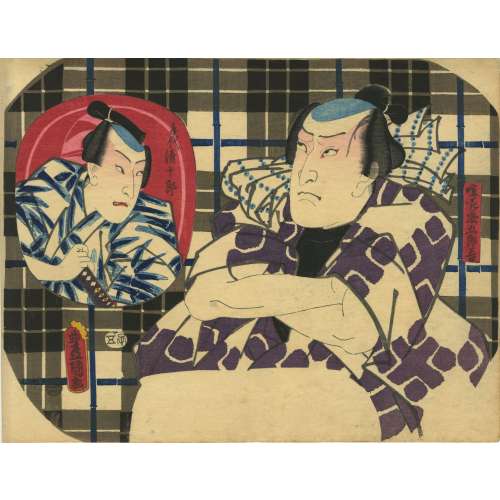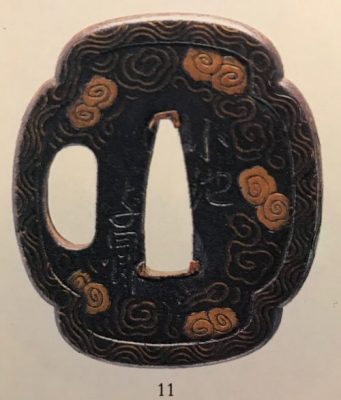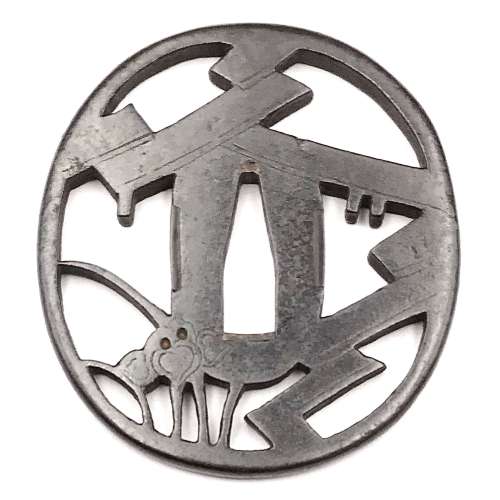Iron tsuba of six-lobed (mutsu-mokkō-gata) form, with six wild boar's eye shape (
inome) openings (
sukashi).
Ryo-Hitsu and the entire perimeter of tsuba have typical for this school raised rim; raised
seppa dai. Lobes are decorated in low relief carving (
sukidashi-bori). On the obverse: chrysanthemum, Genji mon, waves and rocks, grasses and star, bellflower, star and flower in tortoiseshell (kikko). On the reverse: Stars and different flowers, and flying geese. The plate is damaged to the left of
nakago-ana and around the left
hitsu-ana.
Kamakura-bori school.
Late Muromachi period (1514-1573).
Diameter: 89 mm; Thickness at seppa-dai: 4.0 mm; Weight: 108.8 g [large].
There is a similar tsuba in this collection, TSU-0345.2018, but with a different motif and much smaller: diameter 74.3 mm, thickness at
seppa-dai: 3.2 mm, weight: 62.8 g.

Varshavsky Collection: TSU-0345.2018
Another look-a-like tsuba can be found at the Compton Collection, part II, pp. 14-15, №17, though his tsuba is more massive (80 x 84 x 4 mm).

Compton Collection, part II, pp. 14-15, №17: Kamakura-bori tsuba, ca. 1450.
This tsuba, TSU-0401.2019, is the biggest of all three (another mine and the one from Campton Collection). The presence of a flower in a tortoiseshell symbol (crest or mon) on this tsuba alludes to
Izumo Shrine. The overall piece, with symbols of grasses, waves, flowers, incense, stars, and flying geese, is full of autumnal connotations.
 Other similar specimens can be found at:
Henri L. Joly and Kumasaku Tomita, Japanese art and handicraft, "Swords and sword fittings" section, sub-section “Inlays of Ōnin, Kyoto, Fushimi-Yoshiro, and Kaga Province”, Plate CX, #128: Iron, chrysanthemoid, thin guard with alternate petals covered with brass spots. Ōnin style. 16th century.
Other similar specimens can be found at:
Henri L. Joly and Kumasaku Tomita, Japanese art and handicraft, "Swords and sword fittings" section, sub-section “Inlays of Ōnin, Kyoto, Fushimi-Yoshiro, and Kaga Province”, Plate CX, #128: Iron, chrysanthemoid, thin guard with alternate petals covered with brass spots. Ōnin style. 16th century.












 Actors:
Actors:







 English translation of the book indicated above Nihon Tō Kōza, Volume VI, Part 1 by Harry Afu Watson, AFU Research Enterprises, Inc., 1993. Tsuba in question illustrated on page 14 and described as follows: " Tsuba mumei Ōnin. Tetsu ji maru gata ko-sukashi tsuchime shitate shinchū suemon ten zogan maru mimi. Brass suemon". My question remains: why such a text is called 'translation' while it looks more like transliteration of romanization?
English translation of the book indicated above Nihon Tō Kōza, Volume VI, Part 1 by Harry Afu Watson, AFU Research Enterprises, Inc., 1993. Tsuba in question illustrated on page 14 and described as follows: " Tsuba mumei Ōnin. Tetsu ji maru gata ko-sukashi tsuchime shitate shinchū suemon ten zogan maru mimi. Brass suemon". My question remains: why such a text is called 'translation' while it looks more like transliteration of romanization? 
















 Image from
Image from 












 A famous
A famous 

 One more example can be seen in the two upper images at Waseda University Cultural Resources Database, №
One more example can be seen in the two upper images at Waseda University Cultural Resources Database, № 





 A lookalike triptych by Kunisada can be found in
A lookalike triptych by Kunisada can be found in  Data from
Data from